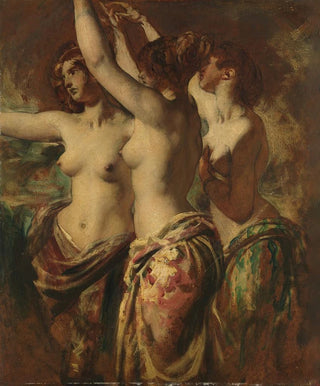Art print | The Three Graces - William Etty


View from behind

Frame (optional)
Les Trois Grâces - William Etty – Captivating Introduction
In the fascinating universe of art history, certain works manage to transcend time and artistic movements. "Les Trois Grâces" by William Etty is a striking example. This iconic canvas, created in the 19th century, evokes timeless beauty and the delicacy of female figures, embodying harmony and sensuality. Etty, as an artist, succeeds in capturing not only classical aesthetics but also an emotional depth that still resonates today. The art print Les Trois Grâces - William Etty allows you to appreciate this masterpiece from a new perspective, while offering an invitation to explore universal themes of beauty and grace.
Style and uniqueness of the work
The uniqueness of "Les Trois Grâces" lies in how Etty blends neoclassical style with a romantic approach. The figures of the three graces, inspired by Greek mythology, are depicted with anatomical precision and a fluidity that evoke movement and life. The color choices, subtly nuanced, give the scene a serene yet vibrant atmosphere. The skillfully used light highlights the delicate curves of the bodies, creating a play of shadows and highlights that accentuate the sensuality of the characters. Every detail, from the draping of the garments to the expressions on the faces, contributes to a harmonious composition, where each grace seems to dialogue with the others. This work is not merely a simple representation; it becomes a celebration of femininity and aesthetics.
The artist and his influence
William Etty, a British painter of the 19th century, is often regarded as one of the pioneers of Romantic painting in England. His fascination with the human body and his ability to depict the female figure with such sensitivity make him a unique artist. Etty, inspired by old masters while incorporating a personal vision, paved the way for many subsequent artists. His work was influenced by the great masters of the Renaissance, but he managed to inject a modernity and emotion that are his own. By addressing themes often considered

Matte finish

View from behind

Frame (optional)
Les Trois Grâces - William Etty – Captivating Introduction
In the fascinating universe of art history, certain works manage to transcend time and artistic movements. "Les Trois Grâces" by William Etty is a striking example. This iconic canvas, created in the 19th century, evokes timeless beauty and the delicacy of female figures, embodying harmony and sensuality. Etty, as an artist, succeeds in capturing not only classical aesthetics but also an emotional depth that still resonates today. The art print Les Trois Grâces - William Etty allows you to appreciate this masterpiece from a new perspective, while offering an invitation to explore universal themes of beauty and grace.
Style and uniqueness of the work
The uniqueness of "Les Trois Grâces" lies in how Etty blends neoclassical style with a romantic approach. The figures of the three graces, inspired by Greek mythology, are depicted with anatomical precision and a fluidity that evoke movement and life. The color choices, subtly nuanced, give the scene a serene yet vibrant atmosphere. The skillfully used light highlights the delicate curves of the bodies, creating a play of shadows and highlights that accentuate the sensuality of the characters. Every detail, from the draping of the garments to the expressions on the faces, contributes to a harmonious composition, where each grace seems to dialogue with the others. This work is not merely a simple representation; it becomes a celebration of femininity and aesthetics.
The artist and his influence
William Etty, a British painter of the 19th century, is often regarded as one of the pioneers of Romantic painting in England. His fascination with the human body and his ability to depict the female figure with such sensitivity make him a unique artist. Etty, inspired by old masters while incorporating a personal vision, paved the way for many subsequent artists. His work was influenced by the great masters of the Renaissance, but he managed to inject a modernity and emotion that are his own. By addressing themes often considered






